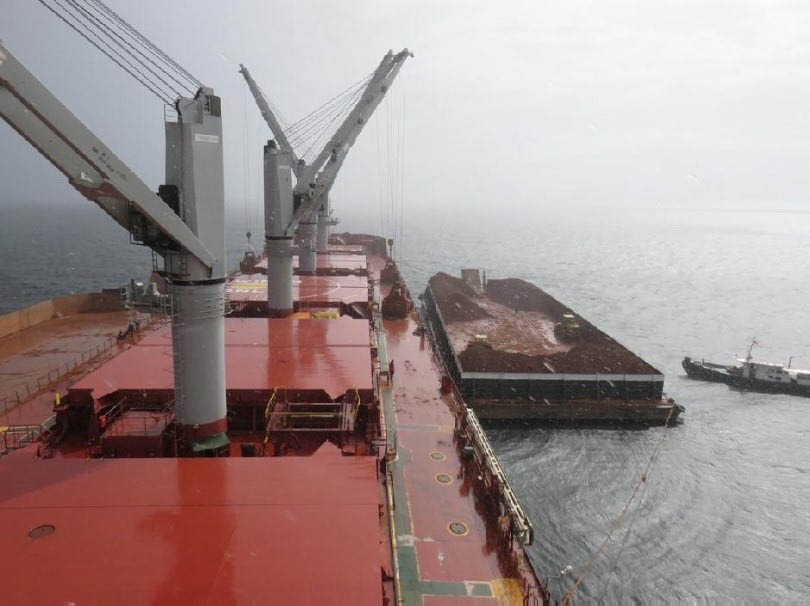 Early on the second day of the New Year in 2015, the Chief Cook of The Bahamas-flagged carrier “Bulk Jupiter,” was ready to start preparing breakfast for the 18 other crew members, when the rough weather and waters worsened.
Early on the second day of the New Year in 2015, the Chief Cook of The Bahamas-flagged carrier “Bulk Jupiter,” was ready to start preparing breakfast for the 18 other crew members, when the rough weather and waters worsened.
The 620-foot (190-metre) vessel rolled even more heavily than the previous day, triggering the sounding of the ship’s alarm, and an urgent intercom announcement from the Master, for their fellow-Filipino workers to hurry to the bridge.
Suddenly, a blackout hit, but the emergency lights flickered on. The 56,000-tonne stricken-ship creaked and listed at a 45-degree angle to starboard, as the Cook struggled to fight his way up the now slanting stairs to the twisting ‘C’ deck, where he and the Master managed to exit the accommodation block and stagger through an emergency side access door, on to a small platform as waves washed over them. In hastily-donned life-jackets, the pair prepared to abandon ship, with the Master and then the Cook, jumping overboard.
Desperate to get away from the sinking vessel, and the deadly vortex of suction it creates as air is displaced, the pair tried to stay together, swimming for their lives. Within minutes, they saw the “Bulk Jupiter” quickly disappear under the wild waters off south-west Vietnam.
Built in 2006 and owned by Gearbulk of Norway, the vessel was mere days into a routine trip, carrying 46,400 tonnes of bauxite from Malaysia to Hong Kong. The “Bulk Jupiter” crew had received an email from their weather-routing provider warning of adverse conditions in the region, but they carried on.
Yet, bad weather was not the main reason behind the “Bulk Jupiter” disaster. The calamity shook up the shipping sector and caused marine specialists to look closely at the strange hazards of some cargo types, which remain largely unknown by the public. The International Maritime Organization (IMO) repeated that operators and shippers should be careful, since granular bulk cargoes such as bauxite can cause liquefaction if the moisture content exceeds safe levels. When ships are moving, certain dry bulk cargoes ranging from crushed ores to mineral sands, containing too much moisture, start to behave weirdly – like liquids. These materials slosh and shift rapidly, creating dangers in the hold, making carriers unstable and potentially causing them to capsize, as happened in the case of the “Bulk Jupiter.”
Last month, the Norwegian-based global marine insurance business, Gard, the largest Protection & Indemnity (P&I) insurer among the 13-member International Group of such Clubs, issued a related alert about Guyanese bauxite shipped by an unidentified company to the United States (US). In an online article, Gard disclosed that a member reported “an incident of cargo failure” and “significant liquefaction,” involving wrongly-categorised ore packed in Guyana that has implications for such exports and the future of the industry.
Gard reported, “The bauxite cargo was showing serious signs of instability when loaded at Linden, Guyana. When the vessel arrived at the discharge port in North America, the cargo in one hold had flattened into a fluid state. The cargo consisted of fine particles and showed significant signs of high moisture content. The cargo was described as ‘cement grade bauxite’, which is a fine grained washed by-product used in cement production.”
The cargo was categorised as Group ‘C’ and not ‘A’ in the shipper’s declaration, the insurer noted, pointing to the IMO’s reiterating, following the “Bulk Jupiter” catastrophe, that bauxite cargoes may suffer instability due to an elevated moisture content. “As such, the IMSBC (International Maritime Solid Bulk Cargoes (IMSBC) Code individual schedule for bauxite was recently revised and the revised schedule entered into force on 1 January 2021. The individual schedule for bauxite now includes a Group ‘A’ category for bauxite fines meant for fine-particulate cargoes liable to liquefy or experience dynamic separation.”
However, “The cargo in this case was declared as Group ‘C’ despite apparently consisting of primarily sand sized particles with a high proportion of silt and clay size fractions. The declaration also listed a Transportable Moisture Limit (TML) of 10%. The TML for Bauxite Fines…. is calculated as the critical water content at either 80% or 70% saturation, subject to determining the point at which a material is approaching full saturation, known as the optimum moisture point (OMC). There is no flow moisture point (FMP) determination using this TML test method.”
Pointing out that no testing certificates were provided, Gard maintained that any cargo with “an inherent propensity to retain moisture and reach a point of saturation will demonstrate an FMP/TML if tested correctly. These cargoes can, by definition, ‘flow’ like a viscous fluid and should be classified as a Group A cargo.”
Local correspondent Cariconsult advised that there are no independent testing facilities for moisture content and no competent authority in the region, to assess the suitability of a cargo for safe shipment, which makes independent confirmation by ship’s interests “difficult and time-consuming,” Gard said. “Can tests” are frequently performed prior to and during loading. Certain bauxites, such as the washed by-product fines in Guyana, retain moisture well when saturated. Such tests cannot confirm if a cargo is safe; they can only give an indication that a cargo may be unsafe and laboratory testing is required before it is accepted for loading, Gard explained.
Independent financial advisers from the United Kingdom, Roxburgh had informed Gard, that fine particulate bauxite has a natural tendency to retain water. Therefore, a “can test” that does not expel water is unlikely to raise any concerns for a ship’s Master, even when the cargo is “potentially dangerously unsafe.”
“Seasonal rains in Guyana have only made the situation more precarious. Guyana has traditionally had two well-defined rainy seasons in December/January and again in May/June. These seasons have become less predictable recently, and this year the country has had almost continuous rainfall since December 2020. The rain showers are frequent and usually very heavy, and come with little warning, giving crews insufficient time to respond with the closing of hatch covers. Bulk carriers with chain-pull hatch covers are not recommended during the rainy season,” Gard cautioned.
Recommending that wary ship-owners assume bauxite loaded in Guyana, of a fine-particulate composition, similar in appearance to silty sand, to be Group ‘A’ material unless proven otherwise by independent testing and reflected in the cargo declaration, the insurer indicated all such cargoes must be accompanied by a TML and moisture content test certificate that should reference the specific IMSBC Code test method and/or ISO (International Organization for Standardization) measurement.
Moisture content must be tested within seven days of loading or any time there is a change in condition such as from rain, Gard added. “Any anomalies in the cargo declarations and test certificates should be questioned and brought to the attention of the Club. Red flags include fine particles cargo declared as Group ‘C’, Group ‘C’ cargo with a TML listed, and moisture certificates dated more than seven days before loading.”
“Gard encourages its members to have a low threshold for contacting the Club if they are fixed or are considering fixing a bauxite cargo from Guyana, and alert the Club if there are any signs of mis-declaration, fine grained or overly wet cargo.”
It was a close call for the unknown ship and unsuspecting crew that made the long journey from Linden to North America. The Cook of the “Bulk Jupiter,” Angelito Rojas, was the only survivor of the disaster. He was rescued after about nine hours, and the bodies of two others recovered. As experts began investigating the cargo properties against the manifest, and the corresponding liquefaction risk, the Swiss company Gearbulk temporarily stopped shipping bauxite. Gearbulk later concluded a secret settlement regarding liability for the tragedy of “Bulk Jupiter,” in which 18 sailors died.
ID looks out at the Caribbean Sea, and wonders about cargo liquefaction and the true reasons for the mysterious disappearance of dozens of Guyanese seamen and their vessels.










